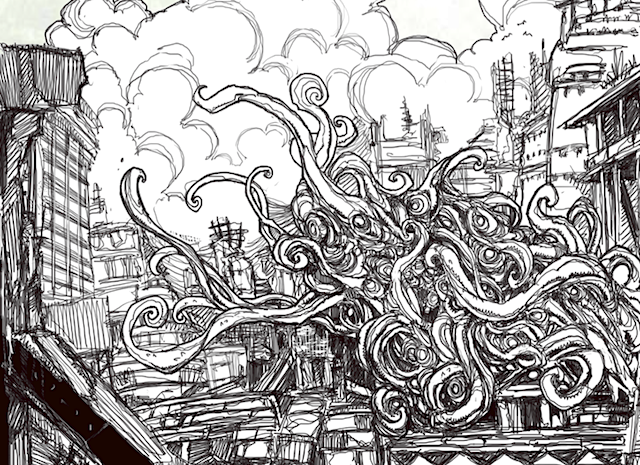Review: The monsters of Carcosa
by Ramanan Sivaranjan on July 09, 2012

As I have mentioned in previous posts about Carcosa, Geoffrey McKinney seems to be working quite hard to say as little as possible about the nature of his “official” game world. There is very little exposition about Carcosa’s history, people, culture, etc. Each section of the book reveals a little bit of Carcosa’s story. The books bestiary reveals the most about the setting, hinting at the nature of the world and some of its history.
The vast majority of the monsters discussed in the bestiary are unique. They are crazy grotesque beasts one might find in a H.P. Lovecraft story.1 The gods of Carcosa are for the most part absolutely terrifying. These creatures have stat blocks and descriptions, like your typical kobold or goblin, so they are ready for your players to battle to the death. I mean, why give a monster hit dice if its not meant to be killed?
A few these monsters reside in particular places (hexes) in Carcosa. In the PDF version of the book, this is mentioned in their description.2 In the hardback you only learn of their home on the planet when reading through the hex descriptions later in the book.
Here looms the great and extinct black volcanic Mount Voormith’adreth, honeycombed with weird and outré caverns, and beneath which bubbles and heaves Shub-Niggurath. – The description of Hex 0402, Carcosa
Of all the old ones that reside on Carcosa, Shub-Niggurath appears to be the most important. Two of the races mentioned in the first section of the book, The Great Race and the Primordial Ones, are spawns of Shub-Niggurath. In addition, 4 other races mentioned in the bestiary are his children, so to speak. The most typical monster found on Carcosa is a Spawn of Shub-Niggurath, which can appear as almost anything. (A disgusting mutant tree? Why not. A horrible giant fish? Of course.) There is an appendix at the back of the book that contains random tables to help the DM with generating these spawns. This one monster description provides a lot of clues into the cosmology of Carcosa.
The remaining monsters of Carcosa provide further insight into what’s happening on the planet. One of the few non-unique monsters are dinosaurs. Of course, this being Carcosa they are expected to be of a crazy mutant variety. Similarly one finds giant jungle ants wandering from hex to hex. Lakes in Carcosa are likely home to to giant lake monsters. These sorts of beasts paired with the descriptions of the 13 races of men hints at a King Kong style world.
As mentioned at the start of the book, there are space aliens. From their description we learn that they originally crash landed on Carcosa a millennia ago, but since then they have established bases and come and go as they please. It’s their presence and their technology that makes the world a little bit less King Kong and perhaps a bit more Flash Gordon.
There are all sorts of slimes, puddings, and oozes similar to those encountered in your typical game of D&D, but with a Carcosa twist. Many of the unique monsters discussed in the bestiary are also some variation of disgusting ooze-like thing with tentacles. If it’s not a giant-mutant-monster it’s probably a creepy slime.
The illustrations by Rich Longmore really bring this portion of the book to life.
The bestiary ends with a brief description (without stats) of the long extinct snake-men. Here we learn some more of the history of Carcosa.
For tens of millions of years the civilizations of the Snake- Men were mighty upon the planet of Carcosa. They delved deeply into the arcane mysteries and laid the foundations of the systematic practice of sorcery. From shambling man- apes the Snake-Men bred the various races of humans to be sacrifices efficacious for their sorcery. At the height of their powers, the Snake-Men destroyed themselves by releasing ultratelluric forces impossible to control.
What else is there to say?
Finally we get to the hex descriptions, which is what it’s all about.
-
As I had mentioned when discussing the sorcerer rituals, each set of rituals deals with one of these unique monsters. The two sections work together to provider a fuller description and background of the monster in question. ↩
-
The level of cross-referencing in the PDF is one big advantage it has over the physical book. Figuring out how everything fits together is much easier when browsing the PDF. ↩
Add me to your circles and we can discuss post on on google+.
